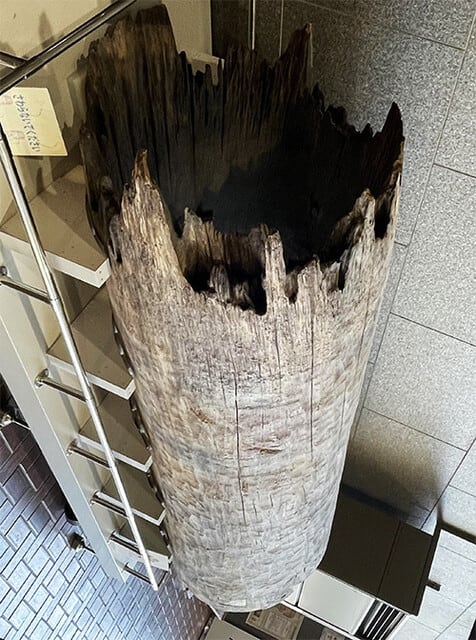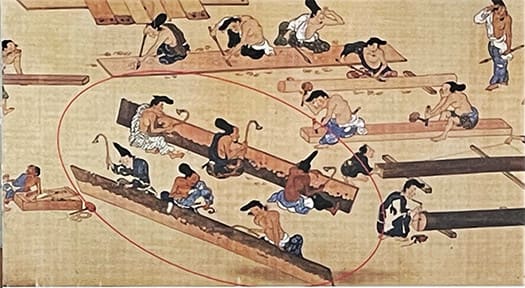


写真は奈良県橿原市の「橿原考古学研究所附属博物館」の玄関に展示されている一木(いちぼく)製の井戸。展示は3枚目の写真のように横たえられているのですが、わたしの個人的趣味で、この井戸が働き続けていたその「状態」を再現したくて、タテの視線に変えてみました。
この井戸は大和郡山市の横田堂垣内遺跡にあったもので、飛鳥・奈良時代の刳り貫き井戸とされています。奈良盆地は全体として「水利」が継続的に課題とされる地域だったとの説明を伺ったことがありますが、河川の管理や、飛鳥の王宮に隣接して設けられた「苑池」に象徴的に置かれたという「人工噴水装置」など、並々ならぬ「治水管理」への王権の意思を感じます。
博物館側の説明を聞いたことはありませんが、苑池の噴水装置とこの「井戸」が同じ玄関のモニュメントとして展示されているのには、そういう意図を感じています。
以下にこの井戸についての説明文(要旨)。
〜横田堂垣内遺跡の「一本刳り抜き井戸」 大和郡山市の横田堂垣内遺跡で奈良時代の大きな井戸が確認されました。堀り方の規模は長径6.2m、短径5.7m、深さ3.3mでその中央にこのヒノキの一木を刳り抜いた井戸枠が据えられていました。長さは3.1m、直系は1.0m。これまでに奈良県内で確認された奈良時代の刳り抜き井戸のなかで、斑鳩町法起寺7次調査で発見のものに次ぐきわめて大きなものです。井戸枠の外面側には手斧(ちょうな)による加工痕跡が明瞭に残っています。<中世の大工技術の参考図参照>
一方内面は比較的平滑に仕上げられています。
井戸枠下方2箇所には方形の孔が穿たれており、そこには外面から別材が嵌め込まれています。この別材には「下」の墨書が認められました。位置は井戸枠の上下と一致しており、井戸設置時、あるいは加工時に必要とされたものと考えられます。〜引用以上。
少なくとも1000年を超えて残ってきた「職人の仕事」痕跡に、深く思いが募ってくる。

対照参考として、東北青森県地方の「浪岡城遺跡」での井戸枠復元の痕跡写真。こちら浪岡城は、青森県青森市浪岡にあった日本の城。1460年代に浪岡北畠氏によって築城され、1578年に大浦為信に攻められ落城ということなので、1000年近い時間差、そして遠隔地域ではありますが、こちらでは四角く木組み構造が構成されている。説明書きでは、まず広く深い大きな穴を掘って、そこにこの「構造」を据え付けて、その外周に土を戻して固定させるという段取りと言うこと。上の奈良県内の刳り抜き井戸とほぼ同様の作業段取りの様子がわかる。
水の確保というもっとも始原的な人間痕跡からは、なにか崇高な部分が感じられて、ずっとこころに沈殿していく気がします。
English version⬇
The technology of wells has supported human life.
Traces of "water utilization" in the Asuka and Nara periods. Traces of civil engineering and woodworking techniques used to "gouge out" giant cypress trees and set them in the ground. I also contrasted the traces of medieval Tsugaru-Namioka in the Tohoku region. The traces of the
The photo shows a well made of ichiboku (one tree), displayed at the entrance of the Museum of the Archaeological Institute of Kashihara in Kashihara City, Nara Prefecture. The exhibit is laid out as shown in the third photo, but for my own personal taste, I wanted to reproduce the "state" in which this well was working continuously, so I changed the view to a vertical perspective.
This well was located at the Yokota-Dogaki-Uchi site in Yamatokoriyama City and is believed to be a gouged well from the Asuka and Nara periods. I have heard it explained that the Nara Basin as a whole was a region where "water conservation" was a continuous issue, and I feel the extraordinary will of the royal authority for "water control management" through the management of rivers and the "artificial fountain device" that was symbolically placed in the "garden pond" adjacent to the royal palace in Asuka.
Although I have not heard the museum's explanation, I sense such an intention in the fact that the fountain device of the Garden Pond and this "well" are exhibited as monuments at the same entrance.
Below is a description (abstract) of this well.
〜A large well from the Nara period was found at the Yokotadodogakuchi site in Yamato Koriyama City. The well was 6.2 m long, 5.7 m short, and 3.3 m deep, with a well frame made of a single gouged out cypress tree placed in the center. The well frame is 3.1 m long and 1.0 m straight, making it the second largest gouged well of the Nara period found so far in Nara Prefecture, after the one discovered in the seventh survey at Hokiji, Ikaruga-cho. The outer surface of the well frame shows clear traces of hand-axe work. <(See the reference figure on medieval carpentry techniques.
The inner surface is relatively smooth.
Two square holes were drilled in the lower part of the well frame, into which another piece of wood was fitted from the outside. The "下" (under) was written in black ink on this separate piece of wood. The position is consistent with the top and bottom of the well frame, and it is thought to have been required at the time of well installation or processing. ~Citation above.
I am deeply moved by the traces of "craftsmanship" that have remained for at least a thousand years.
As a contrasting reference, here is a photo of the trace of a well frame reconstruction at the Namioka Castle site in the Aomori region of Tohoku. This Namioka Castle was located in Namioka, Aomori City, Aomori Prefecture, Japan. the castle was built in the 1460s by the Namioka Kitabatake clan, and was attacked by Oura Tamenobu in 1578 and fell, so there is a time difference of almost 1000 years, and in a remote area, a square wooden frame structure was constructed here. According to the description, a large, deep, wide hole was first dug, and then this "structure" was installed in it, and the earth was put back around the perimeter to fix it in place. This is almost the same process as that used for the gouged-out wells in Nara Prefecture.
The most primitive of human traces, the securing of water, has a sublime quality to it that will remain with us for a long time.



















